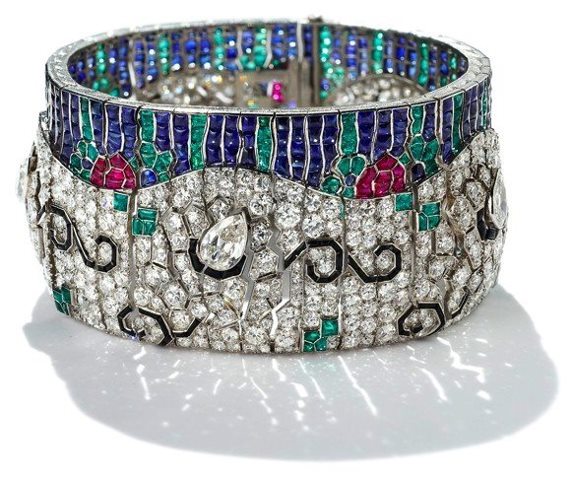Rarity of Art Deco Work Keeps Prices Buoyant
When a Rubel Freres diamond bracelet with a distinctive multi-gem wave effect first appeared at Christie’s New York in 2001, it fetched $336,000. When the rare Art Deco band passed through Christie’s again last October, it went for $506,500 — near the lower end of its $500,000 to $700,000 estimate but still netting a nice profit for its owner despite the trauma, between times, of the worst economic crisis in decades.
Art Deco jewels, characterized by their clean cut and overtly angular design, have continued to perform well at auctions in recent years, “even at a time when the market is not at its best,” said Francois Curiel, President of Christie’s Switzerland and Chairman of Christie’s Asia.
That is mainly because there is very little of it left on the market. Many art deco pieces were broken up after World War II, as the style went out of fashion and owners re-used the stones in new settings: “So, what’s left today brings extremely high prices,” Mr Curiel said.
At Christie’s Geneva auction on May 12, a multi-colored ‘Tutti Frutti’ bracelet of the Art Deco period sold for just over 1 million Swiss francs, or about $880,000, well above its 160,000 franc to 210,000 franc estimate. Other rare Art Deco pieces also performed well. A “Camelia” brooch, designed in about 1926 by Jeanne Boivin, the sister of the renowned French couturier Paul Poiret, sold for 159,000 francs against an estimate of 32,000 francs to 42,000 francs while a 1933 pair of “Coquillage Ailé” ear clips, shaped like winged shells, also by Ms. Boivin, sold for 68,750 francs against an estimate of 14,000 to 18,000 francs.
While some jewelry may be worth just the intrinsic value of its stones, Art Deco commands much more, reflecting the value set by collectors on its design, said Lisa Hubbard, a senior vice president in Sotheby’s international jewelry division.
The Art Deco movement, which first appeared in the mid 1920s, permeated all aspects of popular culture, from fashion to architecture. In jewelry it sided defiantly with modernism in its clear, geometric lines, sharp angles, stark contrasts of light and dark, or hard all-white fields of platinum and diamonds.
“What Cartier, and all the other major houses of the time did, was break with the past. As women’s hair was cut short and the fashion of the day was much less constructed, jewelry design also changed,” Ms. Hubbard said. “You started seeing precious stones being mixed with hard stones, like quartz, jade, onyx. There was an added tactile aspect, with polished surfaces versus mat surfaces.”
While Art Deco is most typically associated with the geometric style, it also came under other influences, especially in the 1920s. “This was a time of great explorations around the world. You see influences from Egypt, China, Africa,” Ms. Hubbard said. Art Deco designers, she said, sought to capture and recreate the exoticism of far away places, for a European and American audience.
The discovery of King Tutankhamun’s tomb in 1922 ensured that ancient Egypt would be a major influence. India, and the opulence of its Maharajas, was another. “Cartier’s Tutti Frutti style of jewels was a reworking of Mughal jewelry for a Western audience,” Ms. Hubbard said. These flamboyant pieces became a signature of the house in the 1920s. One of the most striking examples, the “Hindu necklace” commissioned from Cartier by the U.S. heiress and socialite Daisy Fellowes in 1936, was almost certainly based on one the jeweler made in 1935 for the Maharajah of Patna.
“They did a very limited number of such pieces, so when they come up, they command high prices,” Ms. Hubbard said.
Most Art Deco jewelry sales take place in New York and London, since U.S. and European collectors are the main buyers. But in recent years, demand has also developed in Asia. On June 1, Christie’s will offer in its Hong Kong sale two Art Deco diamond bracelets by Cartier.
The auction house hopes to nurture similar interest amongst Middle Eastern buyers after including Art Deco pieces in its Dubai offering for the first time in April.
“Christie’s was the first international auction house to establish jewelry auctions in Hong Kong in 1993 and those early auctions included a small amount of Art Deco jewelry. We now have avid collectors of important Art Deco jewelry all over South East Asia,” said David Warren, international director of jewelry for Christie’s Dubai. “The same growing interest in 1920s jewelry is likely to develop in the Middle East over time.”
For the Dubai sale, Christie’s chose pieces with Middle Eastern references, including a 1920s Cartier bracelet and brooch set decorated with a pierced Moorish geometric motif. They sold for $86,500, well above the $30,000 to $40,000 estimate.
A version of this article appears in print on May 21, 2010, in The International Herald Tribune.
